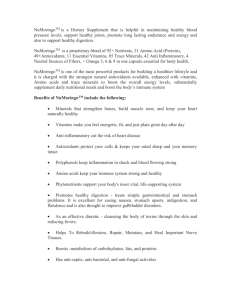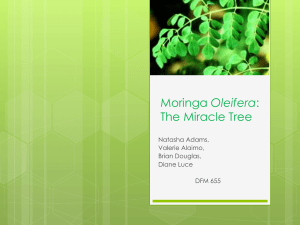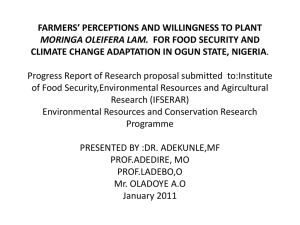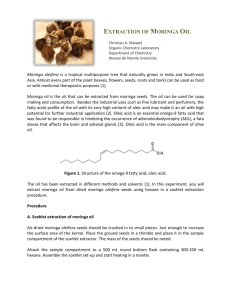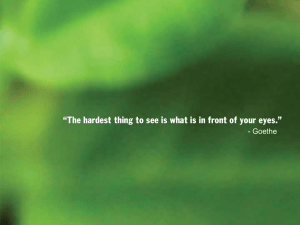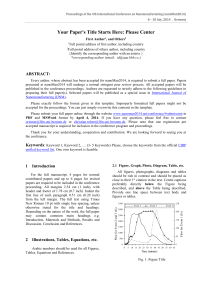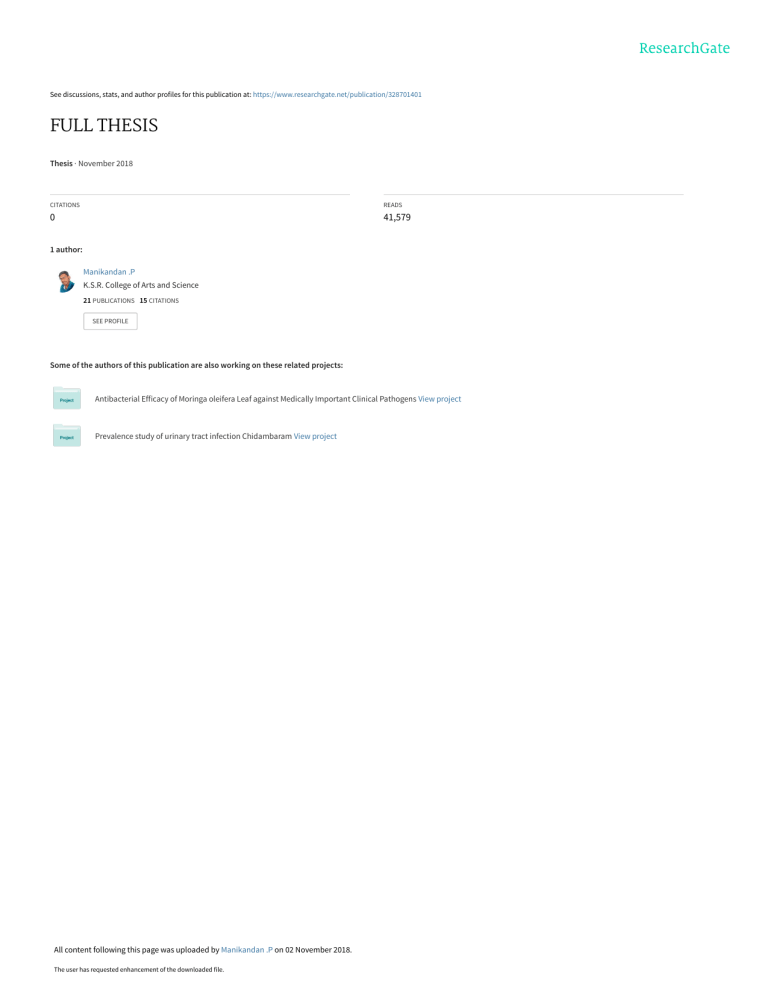
See discussions, stats, and author profiles for this publication at: https://www.researchgate.net/publication/328701401 FULL THESIS Thesis · November 2018 CITATIONS READS 0 41,579 1 author: Manikandan .P K.S.R. College of Arts and Science 21 PUBLICATIONS 15 CITATIONS SEE PROFILE Some of the authors of this publication are also working on these related projects: Antibacterial Efficacy of Moringa oleifera Leaf against Medically Important Clinical Pathogens View project Prevalence study of urinary tract infection Chidambaram View project All content following this page was uploaded by Manikandan .P on 02 November 2018. The user has requested enhancement of the downloaded file. INTRODUCTION Medicinal plants have been used for centuries as remedies for human diseases because they contain components of therapeutic value. The plants have always been vital for mankind irrespective of the era and area all over the globe since the beginning of life. These were and will remain ever beneficial from nutritional, social, cultural, religious, environmental and human’s etc. However, a very important step in the screening of the sanitizing and preservative activity of a plant material is to evaluate its antimicrobial properties. It is important to evaluate the antimicrobial properties of Moringa oleifera leaves on some selected microorganisms and also to verify its Phytochemical constituent. Medicinal plants contain numerous biologically active compounds, many of which have been shown to have antimicrobial properties. Plantderived medicines have been part of traditional healthcare in most parts of the world for thousands of years and there is increasing interest in plants as sources of agents to fight microbial diseases. Medicinal plants are a source of great economic value in the Indian subcontinent. Nature has bestowed on us a very rich potancial wealth and a large number of diverse types of plants grow in different parts of the country. India is rich in all the three levels of biodiversity they are namely species diversity, genetic diversity and habitat diversity. In India thousands of species are known to have medicinal value and the use of different parts of several medicinal plants to cure specific ailments has been in vogue since ancient times. 1 Today the pathogenic bacteria have developed resistances against existing antibiotics due to indiscriminate use of antimicrobial drugs to treat infectious disease. The antimicrobial resistant bacteria are the causes of numerous clinical problems worldwide. The development and increase of resistance among pathogens causing nosocominal and community acquired infection are known to be associated with the widespread utilization of antibiotics. Moringa oleifera is a well-documented world removed plant herb known for is extraordinary nutritional and medicinal properties. It is a known antihelminth; antibiotic detoxifier and an outstanding immune builder used in many countries tit ret malnutrition and malaria. The plant Moringa oleifera is a highly valued plant, distributed in many countries of the tropics and subtropics. Phytochemicals are chemical compounds that are naturally found in plant. They are responsible for the colour and organoleptic properties of the plant. It is also referred to as those chemicals that may have biological significance but are not established as essential nutrients in plant. Phytochemicals could be available as dietary supplements, but the potential health benefits of Phytochemicals are derived from consumption of the whole plant. Moringa oleifera is considered to be effective in the treatment of many diseases. It is an exceptionally nutritious vegetable tree with a variety of potential uses. The tree itself is rather slender, with dropping branches. It is often cut back annually to one meter or less and allowed to re-grow so that its pods and leaves remain within arm’s reach. Moringa tree is mainly grow in the semi-arid tropical and subtropical areas. It grows best in dry sandy soil and can tolerate any other type oil soil. It is fast growing drought resistant tree that is 2 native to the Southern foothills of Himalayans in Northern India. It is considered as one of the world’s most useful tree. In traditional medicine Moringa oleifera tree is known is known as a miracle tree as almost every part of this tree possesses product useful for humans. The leaves and pods are eaten. The plant is also reported to be medicinally important and almost all parts of the Moringa oleifera tree considered to possess medicinal properties and are used in the treatment of as cites, rheumatism venomous bites cardiac and circulatory stimulant. Moringa leaves are known to have a high content of protein, minerals and vitamin, hence an ideal nutritional supplement. Moringa oleifera leaves have been used to combat malnutrition, especially among infants and nursing mothers and hasten uterine contract ion during child birth in pregnant women. It’s antihypertensive, diuretic, antispasmodic, antiulcer, and anticancer and cholesterol lowering activities have been reported. The leaves are helpful in increasing breast milk in nursing mothers during breast feeding and leaf decoction has been found useful in the treatment of asthma, back pain and rheumatism. Moringa oleifera tree has in recent times been advocated as an outstanding indigenous source of highly digestible protein, carotenoids and vitamin C suitable for utilization in many of the so called developing regions of the world where under nourishment is a major concern. In some parts of the world for example Senegal and Haiti, health workers have been treating malnutrition in small children, pregnant and nursing women with Moringa leaf powder. The Moringa tree is considered one of the world’s most useful trees, as almost every part of the Moringa tree can be used for food or has some other beneficial properties. In the tropics, it is used as forage for livestock, and in 3 many countries, it is used as a micronutrient powder to treat various ailments. The fruit of the tree is quite popular as a vegetable in Asia and African countries. In India and other parts of the country the fruit called as drumstick. The leaves contain more Vitamin A compared to carrots, more calcium than milk, more iron than spinach, more Vitamin C than oranges, and more potassium than bananas, and that the protein quality of Moringa leaves rivals that of milk and eggs. The Moringa trees have been used to combat malnutrition, especially among infants and nursing mothers. The non govern mental organizations in particular-Trees for Life, Church World Service and Educational Concerns for Hunger Organization—have advocated Moringa as natural nutrition for the tropics. Its leaves as food supplement, recommended for children with moderate malnutrition between the ages of 6 months to 5 years. It has been claimed to have an unusually high content of calcium, iron, and vitamin A and high quality protein, and a low content of anti nutrients (Natural or synthetic compounds that interfere with the absorption of nutrients) such as tannins and oxalates. The leaves have therefore been promoted as a potential low cost high quality food. 4 AIM AND OBJECTIVES To validate the potential of the selected medicinal plant for its anti microbial properties. Phytochemicals screening of the selected plant extract. 5 REVIEW OF LITERATURE Yogeshkumar et al., (2007) the methanol and acetone extracts of 14 plants belonging to different families were evaluated for antimicrobial activity against certain Gram positive and Gram negative bacteria and some of fungi. For the detection of antimicrobial activity, they use agar disc diffusion methods. In their study they concluded that the methanol extracts showed more antibacterial activity then acetone extracts. Memnune Sengul et al., (2009) according to their Antimicrobial activity and antioxidant activity of medicinal plant. β-carotene bleaching assay and Folin-Ciocalteu reagent were used to determine total antioxidant activity and total phenols of plant extract. Antimicrobial activity was determined by using disk diffusion assay. The results provided evidence that the studied plant might indeed be potential source of natural antioxidant and antimicrobial agents. Bukar et al., (2009) worked on the anti-pseudomonal activities aqueous, chloroform and ethanol extracts of leaf of Sienna siamea (Lam) were evaluated by agar disc diffusion method. This was aim of substantiating the Ethanomedicinal use of the plant as anti-bacterial. Ciprofloxacin (oxide) as positive control had zone diameter of inhibition of 35mm in all test plates. However aqueous extract proved to be a more suitable candidate for use in the treatment of disease cause by Pseudomonas aeruginosa. Khawaja Tahir Mahmood et al., (2010) in their work on the therapeutic uses of selected plants. Moringa has been used since 150B.C. by ancient kings and queens in their diet for mental alertness and healthy skin. 6 Moringa are used in more than 80 countries. It is also improves eyesight, mental alertness and bone strength and provide excellent support of the body’s anti-inflammatory mechanisms, enrich anemic blood and support immune system. We need to explore therapeutic, nutritional and benefit of this gift of nature reported to be one of the world’s most useful trees. Thilza et al., (2010) says about the in vitro antibacterial activity of the water extract of Moringa oleifera. The highest activity was produced by Escherichia coli at 1000mg/ml which comparably is less than of the standard drug Tetracycline (250mg/ml),this study has shown that the water extract of Moringa oleifera posses some degree of antimicrobial activity especially at high dose. Gustavo Hitzschky Fernandes et al., (2010) reported the antibacterial effect against gram positive and gram negative bacteria. Using solvent aqueous and ethanol extract. The aqueous extracts of soursop showed an antibacter ial against Staphylococcus aureus, Vibrio cholera but the antibacterial activity by the ethanol extracts of this plant was not demonstrated. Bukar et al., (2010) the chloroform and ethanol extracts of seeds and leaf Moringa oleifera were investigated for antimicrobial activity against some selected food-borne microorganisms. The preliminary phytochemical screening and antimicrobial assay were carried out using standard procedures. Saponins were detected in all the extracts while tannin’s was only detected in Moringa oleifera leaf chloroform extract. The MIC values ranged between 1.0 and >4.0mg/ml for the tested organisms respectively. Josephine et al., (2010) it established the medicinal uses of Moringa oleifera leaves in Uganda and identified Phytochemicals preset in Moringa 7 oleifera leaves extracts. Phytochemicals present included tannins, steroids, triterpenoids, flavanoids, saponins, anthraquinones, alkaloids, and reducing sugars. There is need to standardize Moringa oleifera leaves use for nutrition and herbal medicine. Renu Solanki et al., (2010) reported about the antimicrobial properties of Cassia fistula, Acacia aroma, Azadirachta indica, Ziziphora clinopodiodies, and Argemone mexicane etc. a review of some patents on herbal products for the treatment of bacterial disease is provided that highlights the recent technical advancements that have taken in this area. Devendra et al., (2011) in folklore, and ayurvedic all parts of the tree used in different healing procedures for different diseases. This plant leaves are very good nutrient supplement for mall nutrition and also used antibiotic. So this plant extracts having good healing properties without side effects when compared with synthetic antibiotics. Mohammed Abu Sayeed et al., (2012) the present study was designed to investigate antibacterial and antifungal activity of Methanol extract from the fruits of Moringa oleifera. The extracts were screened for antibacterial and anti fungal by Disk diffusion method. The highest zone of inhibition was found at the concentration of 200µg/ disk for Pseudomonas aeruginosa (22 mm) and Collectitrichum Sp (14 mm). Vinoth et al., (2012) worked on the preliminary photochemical screening indicated the presence of phenolics, flavanoids, tannins, glycosides etc. We believe that the higher reducing power of the aqueous extract could be due to the better solubility of the antioxidant components in water whereas the predominant antibacterial activity in organic solvent extracts as compared to 8 aqueous extracts, indicates that the active components responsible for the bactericidal activity are more soluble in organic solvent. These studies provid e an evidence to support traditional medicinal uses of the plant. Mudasser Zaffer et al., (2012) studied about the Chloroform, Ethyl acetate, Methanol and aqueous extracts of Moringa oleifera bark traditionally used in folkloric medicine for the treatment of various infections were investigated for their antifungal activity against two fungal strains. The results provide justification for the use of the plant in folk medicine to treat various infectious diseases. Abalaka et al., (2012) studied about the evaluation of the antibacterial activity of medicinal plant. The chloroform extracts of Moringa oleifera (leaves) and using the standard disc diffusion method and photochemical analysis against four strains of bacterial species. Kaniz Fatima Urmi et al., (2012) done the project aim of the present study was to determine the antimicrobial and cytotoxic activity of different parts of the plant Moringa oleifera Lam. Disc diffusion method and brine shrimp lethality bioassay were used for antimicrobial activity and cytotoxic activity respectively. Chloroform fractions of leaf and fruit part have shown moderate antimicrobial activity within zone of inhibition ranging from 9-28mm against all the experimental microbes. Gruvinder Pal Singh et al., (2012) reported about the antimicrobial evaluation of Moringa oleifera Lam. The root and bark are useful in treatment of heart complaints, eye diseases, inflammation, dyspepsia and enlargement of spleen. In the present study the antimicrobial activity was investigated by employing main model Kirby-Bauer disk diffusion method. 9 Rockwood et al., (2013) worked on the Moringa oleifera seeds and leaves were extracted using three different solvents (de-ionized water, inorganic ethanol, and organic ethyl acetate) and two different extraction methods (crude, sophisticated). Sensitivity disks impregnated with the various extracts were used for antibiotic susceptibility testing of fourteen bacterial species: seven representatives Gram-negative and seven representatives Grampositive. De-ionized water was the only solvent capable of extracting plant constituents which conferred bacterial inhibition. Seed extracts were found to inhibit a broader range of organisms (4) than leaf extracts (1). 75% of the organisms inhibited by seed extracts were Gram-positive bacteria. A single parameter, the zone of inhibition, was used to compare antibacterial efficacy between extraction methods, trials, and controls. No difference was observed between the zone of inhibition of crude and sophisticated extracts. Seed extracts demonstrated a zone of inhibition comparable to that of penicillin and tetracycline. Makanjuola et al., (2013) worked on the Antibacterial activities of Moringa oleifera leaf extracts were carried out on coli forms isolated from surface waters using growth inhibition indices based on agar plate technique. The minimum inhibitory concentration ranged from 4.0 mg/ml to 35.0 mg/ml, while the minimum bactericidal concentration ranged from 5.0 mg/ml to 45.0 mg/ml. The antibacterial activities examined in this study showed that Moringa oleifera leaves are capable of exerting inhibitory effect on the target organisms. Theophilus et al., (2013) studied about the Phytochemical screening and antibacterial assays on Moringa oleifera leaves extract have been documented but none of the reports showed the fractionation and separation of the phytoconstituents by solvent extraction and thin layer chromatographic 10 procedures, respectively. The antibacterial assay results portrayed broad activity spectrum against the test microbes with comparable inhibitory zones by standard antibiotics. The MIC ranged between 10mg/ml and 90mg/ml for all the organisms. The results from this research have shown the antibacterial potentials of Moringa oleifera implying that the extract could help as a chemotherapeutic agent or might be a lead compound for the development of new potent antibacterial agents. Ugwu Okechukwu et al., (2013) acute toxicity and phytochemical studies of ethanol leaf extract of Moringa oleifera were analysed. The Phytochemical analyses of the ethanol extract of Moringa oleifera leaf showed the presence of tannins, carbohydrates, saponins, glycosides, reducing sugars, terpenoids, steroids, flavanoids and alkaloids. Phytochemicals such as resins, proteins and fat oils were not detected. The LD50of the ethanol leaf extract in mice was found to be less than 5000mg/kg body weight. Philip et al., (2013) Moringa oleifera defatted seed and seed coat was conducted. Paper disc diffusion method was used to assess the effect of the extracts on Pseudomonas aeruginosa, Escherichia coli, Klebsiella sp, Salmonella typhi, Proteus mirabilis, all the examined extract showed varying degrees of antibacterial activities against the selected pathogens. Highest inhibitory effect was observed in Proteus mirabilis (19mm) following Salmonella typhi (16mm) with the Moringa oleifera seed extract, these strains Salmonella typhi and Proteus mirabilis were resistant to ethanol extract of Moringa oleifera seed coat along with their respective minimum inhibitory concentration (MIC) values ranging from extract on the test isolates ranges from a 0.1mg/ml- 100mg/ml concentration. 11 Mona et al., (2013) accordingly, rocket (Eruca vesicaria sub sp. Sativa) plants were foliar sprayed with the aqueous extracts of leaves and twigs of Moringa oleifera at rates of 1, 2 and 3%. Among these concentrations, fertilization of rocket plants with 2% leaf and 3% twig extracts potentially increased all measured growth criteria (plant height, fresh and dry herb weight), photosynthetic rates, stomatal conductance, the amounts of each of chlorophyll a and b, carotenoids, total sugars, total protein, phenols, ascorbic acid, N, P, K, Ca, Mg, Fe as well as growth promoting hormones (auxins, gibberellins and cytokinins). Kalpana et al., (2013) worked on the antimicrobial activity of petroleum ether, chloroform, ethanol and aqueous extracts of Moringa oleifera leaf against four microorganism’s viz., Escherichia coli, Staphylococcus aureus, Klebsiella pneumoniae and Streptococcus pneumoniae. The antimicrobial activity was performed by Kirby-Bauer disc diffusion method. Ethanolic extract showed maximum zone of inhibition against Staphylococcus aureus. Patil et al., (2013) ) studied about, antioxidant activity and in vitro antibacterial activity of acetone, methanol and chloroform extracts of Moringa oleifera roots were investigated., The antibacterial effects of Moringa oleifera alone as well as in combination with Cleome viscosa against all tested pathogens suggest their potential use as alternative tools for controlling otitis media. Ashok et al., (2014) The antibacterial activity of leaf extracts of Moringa oleifera and Saraca indica was evaluated in vitro, using disc diffusion method. Six different extracts each for both the plants were used which included aqueous, acetone, chloroform, ethanol, methanol and petroleum ether. 12 The study showed that aqueous and ethanol extract of Moringa oleifera was inhibitory against Escherichia coli (12mm each), Proteus vulgaris (10mm each) and Salmonella typhi (12mm and 10mm respectively). Moringa oleifera leaf extract showed that Bacillus subtilis and Klebsiella pneumoniae were resistant to all the extracts. Eman et al., (2014) Moringa oleifera leaves can be used as a medicine for many diseases, as antibacterial, antioxidant, anticancer. In addition it can be used as a protein supplement for human being and animals due to high protein content. Moringa oleifera leaves are unique because of their tremendous amounts of minerals but lower amounts of harmful compounds and it can be considered as safe supplement because besides that it is not toxic Riad et al., (2014) describe the first record on resistance of Moringa oleifera plants against root rot and wilt diseases caused by Fusarium solani , Fusarium oxysporum , Rhizoctonia solani , Sclerotium rolfsii and Macrophomina phaseolina .There is no clearly effect of the tested pathogens on vegetative growth parameter such as plant height , fresh and dry weight of shoots and roots of Moringa . It could be suggested that seeds and media used for Moringa ought to be sterilized with hypochlorite or another material or procedure to ensure good seed emergence and control seed and soil borne pathogenic fungi. Mudasser Zaffer et al., (2014) Moringa oleifera were evaluated for their antibacterial activity against four bacteria viz. Staphylococcus aureus, Citrobacter freundii, Bacillus megaterium and Pseudomonas fluorescens using erythromycin as positive control. The activity was analyzed using paper disc diffusion method at different concentration of the extract. The study revealed that all the bark extracts irrespective of their types, in different concentrations 13 inhibited growth of the test pathogens to varying degrees. Ethyl acetate extract showed maximum activity against all the bacterial strains followed in descending order by chloroform, methanol and aqueous extracts. Tona et al., (2014) Sixty one days feeding trial was conducted to determine the total feed intake, live weight gain and digestibility coefficients of WAD goats (bucks) fed basal diet of Panicum maximum (guinea grass) and concentrate diet containing Moringa oleifera leaf meal (MOL) at 0%, 5%, 10% and 15% levels. The results showed that the WAD goats fed the concentrate diet with 15% level of inclusion of Moringa oleifera leaf meal had significantly higher (P<0.05) rate of growth and digestibility coefficients than those on the 5% and 10% inclusion levels. Kodia et al., (2014) This study shows that we can overcome Buruli ulcer with medicinal plants that is abundantly available in Africa. It also shows that it is necessary to conduct research on a wider range of fract ions of Moringa oleifera to improve the activity of anti mycobacterienes molecules in the aqueous extract of Moringa oleifera. Namrata Prasad et al., (2014) In this paper leaves of Moringa oleifera, Dalbergia sissoo and Alstonia scholaris in different solvent were subjected to antibacterial analysis against selected bacterial pathogens and Phytochemical analysis was done. The dry crude sample extracts were tested for its antibacterial activities using agar well diffusion technique. These samples were further taken to determine the MIC value. The MIC value was determined using broth dilution method. Acetone and ethyl acetate extracts of Moringa oleifera were subjected to get MIC against Staphylococcus aureus and it was found to be 0.003mg/ml and 0.096mg/ml respectively. MIC values for methanolic extract of Dalbergia sissoo were 0.386 mg/ml for 14 Staphylococcus aureus and 0.005 mg/ml for Pseudomonas aeruginosa. Important sources of Phytochemicals pharmaceutical potential were present. 15 of immense medicinal and MATERIALS AND METHODS Antimicrobial properties of Moringa oleifera were screened by Disc diffusion method. COLLECTION OF PLANT MATERIALS The material used in the present study was the plant Moringa oleifera collected from Pokkam Palayam, Namakkal District, and Tamilnadu, India. PLANT (MORINGA OLEIFERA): Plate 1 The plant MORINGA OLEIFERA is also known as horseradish tree or benzoil tree. It is a species of the genus Moringa in the Moringaceae family. GENERAL DESCRIPTION Moringa oleifera is a fast-growing tree. It can reach a height of 10–12 m (32-40 ft) and the trunk can reach a diameter of 45 cm (1.5 ft). The bark has a whitish-grey colour and is surrounded by thick cork. Young shoots have purplish or greenish-white, hairy bark. The tree has an open crown of drooping, fragile branches and the leaves build up feathery foliage of leaves. The flowers are about 1.0-1.5 cm long and 2.0 cm broad. They grow on slender, hairy stalks in spreading or drooping later flower clusters which have a length of 10–25 cm. The fruit is a hanging, three-sided brown capsule of 20–45 cm size which holds dark brown, globular seeds with a diameter around 1 cm. The seeds have three whitish papery wings and are dispersed by wind and water. 16 PREPARATION OF EXTRCTS The dried plant material was crushed in to fine particles (powder) using a mixer. About 25 grams of each plant powdered material was separately extracted with 100 ml of solvents (Acetone, Chloroform, Methanol and Petroleum ether) respectively. All the solvents were kept at room temperature, for 7days to allow the extraction of compounds from plants. Each mixture was stirred every 24 hours using sterile glass rod. The greenish extracts were obtained and passed through the whattman filter paper No: 1 and the respective solvents were evaporated (at 40°C) with the help of heating mantel. The sticky black substances were obtained and stored in refrigerator and these are suspended/ dissolved in DMSO (Dimethyl Sulphoxide) prior to use. MICROBIAL INOCULUM PREPARATION The young microbial inoculums / culture was prepared and used in the entire research period. The nutrient broth was prepared and poured into several tubes and sterilized. The pure microbial cultures were collected from the Microbiology Department of the institute (either solid or liquid medium) and inoculated in the tubes using inoculation needles or loops, after that all the tubes were incubated at different temperatures and time duration (at 37° C for 24 to 48 hours). SCREENING FOR ANTIBACTERIAL ASSAY The antibacterial activities of the plant were tested against the selected bacterial strains. The sterilized Mueller Hinton agar medium was poured in to each sterile petriplate and allowed to solidify. Using sterile cotton swabs the test bacterial cultures were evenly spread over the appropriate media. The sterile discs were individually loaded with different concentrations of organic solvents 17 extracts (Acetone, Chloroform, Methanol, and Petroleum Ether) of the plant. These discs were kept in undisturbed place for the evaporation of the solvents. Then the discs were placed on the top layer of the Petri dishes pertaining to the test cultures. All the plates were incubated at 37°C for 24-48 hours. After the incubation period the results were observed and measured the diameter to demarcate inhibition zone around the each disc/ organism. MICROBIAL STRAINS USED FOR ANTIBACTERIAL ASSAY Ten different bacterial strains are used for the antibacterial assay they are, Escherichia coli, Staphylococcus aureus, Bacillus sp, Streptococcus pyogens, Proteus sp, Salmonella sp, Shigella sp, Pseudomonas aeruginosa, Klebsiella sp, Streptococcus mutants. PRELIMINARY PHYTOCHEMICAL SCREENING Various extracts collected from the shade-dried powdered stem bark of Moringa oleifera was tested for identification of its active chemical constituents. TEST FOR ALKALOIDS To the small quantity of test solution, a few drops of diluted Hydrochloric acid was added and filtered. The filtrate may be tested carefully with various alkaloidal reagents such as, a) Mayor’s reagent – Creamy precipitation b) Dragondroff’s reagent – Orange brown precipitate c) Hager’s reagent – Yellow precipitate d) Wager’s reagent – Reddish brown precipitation 18 TEST FOR FLAVONOIDS a) To the small quantity of test solution, add aqueous sodium hydroxide solution, appearance of blue to violet colour indicates the presence of anthocyanins, yellow colour indicates the presence of flavones, yellow b) To the small quantity of test solution, add concentrated sulphuric acid indicates the presents of anthocyanins, yellow to orange colour indicates the presence of flavones and orange to crimson colour indicates the presence of flavonones. C) Shimoda’s test: The small quantity of test solution is dissolved in alcohol, to that piece of magnesium followed by concentrated hydrochloric acid drop was added and heated. Appearance of magneta shows the presence of flavanoids. TEST FOR TANNIN To the small quantity of test solution was taken separately in water and tested for the presence of tannin. 1) Dil. Ferric chloride solution (5%) – Violet colour 2) 1% Solution of gelatin containing 10% Nacl – White precipitate 3) 10% Lead acetate solution – White precipitate TEST FOR CARBOHYDRATES To the small quantity of test solution was dissolved in 5ml of distilled water and filtered was subjected to test for carbohydrates. 19 a) Molish test: The filtrate was treated with 2-3 drops of 1% alcoholic alpha napthol and 2ml of concentrated sulphuric acid was added along the sides of the test tubes. b) Fehling’s test: The filtrate was treated with 1 ml of fehling’s solution and heated. Orange precipitate was obtained shows the presence of carbohydrates. TEST FOR SAPONINS Small quantity of test solution was diluted with 20 ml of distilled water and it was agitated on a graduated cylinder for 15 minutes, the presence of saponins was indicated by the formation of 1 cm layer of foam. TEST FOR TRITERPENOIDS 1) Salkowski Test: Approximately 2 mg of dry extract was shaken with 1 ml of chloroform and a few drops of concentrated sulfuric acid were added along the side of the test tube. A red brown color formed at the interface indicated the test as positive for triterpenoids. TEST FOR PHYTOSTEROLS Liebermann Burchard’s Test The small quantity of test solution was dissolved in few drops of dry acetic, 3ml of acetic anhydride was added followed by few drops of conc. Sulphuric acid. Appearance of bluish green colour indicates the presence of phytosteroles. 20 RESULTS SCREENING OF ANTIMICROBIAL ACTIVITY Four different organic solvents (Acetone, Chloroform, Methanol, Petroleum Ether) at various concentrations (25µl, 50 µl, 75 µl, 100 µl) of Moringa oleifera was evaluated for its antimicrobial activity. Both Gram positive and Gram negative organisms were screened in this study. The results were tabulated in Table 1, Plate 1-2 The results of the present study shoes that most of the organic solvent extracts of Moringa oleifera Leaf showed significant activity against the tested bacterial strains. The disc containing lest amount of solvent extract, 25µl/ disc had similar antibacterial activity of the tested microorganisms, Escherichia coli (8 mm), Staphylococcus aureus (11 mm), Klebsiella sp (11-17 mm), Pseudomonas aeruginosa (9-15 mm), Streptococcus pyogens (11-15 mm), Proteus sp (15 mm), Salmonella sp (8-12mm), Shigella sp (8-12mm), Streptococcus mutants (11 mm), Bacillus sp (10-20 mm) In case of 50 µl shows a fair antibacterial activity against the bacterial tested, Escherichia coli (9 mm), Klebsiella sp (9-17 mm), Staphylococcus aureus (11-14 mm), Pseudomonas aeruginosa (9-10 mm), Streptococcus pyogens (7-18 mm), Proteus sp (10-17mm), Salmonella sp (817mm), Shigella sp (8-17mm), Streptococcus mutants (12mm), Bacillus sp (12-21mm). 21 The disc containing 75 µl/ disc extracts showed a better result, Escherichia coli (9-13 mm), Staphylococcus aureus (10-17 mm), Klebsiella sp (11-15 mm), Pseudomonas aeruginosa (11-13 mm), Streptococcus pyogens (820 mm), Proteus sp (11-21mm), Salmonella sp (9-17mm), Shigella sp (917mm), Streptococcus mutants (9-12mm), Bacillus sp (12-24mm). The higher concentration of the extract 100 µl/ disc shows a good activity the Staphylococcus tested aureus organisms, (12-20 Escherichia mm), Klebsiella coli sp (10-18 mm), (10-17 mm), Pseudomonas aeruginosa (12-16 mm), Streptococcus pyogens (8-28mm), Proteus sp (11-31mm), Salmonella sp (10-20mm), Shigella sp (13-27mm), Streptococcus mutants (10-15mm), Bacillus sp (12-28mm). (Table.1) PHYTOCHEMICAL ANALYSIS OF MORINGA OLEIFERA The presence of Phytochemicals in the plant under study was evaluated. It is reported to predominantly contain a wide range of chemicals in different extracts. The acetone extract contains the following constituents, Terpenoids, Tannins, Saponins, Flavanoids and Alkaloids. The chloroform extract contains Carbohydrates, Terpenoids, Tannins, Saponins, Flavanoids and Alkaloids. The methanol extract contains Terpenoids and Phyto Steroids. The petroleum ether extract contains Alkaloids, Flavanoids, Saponins, Terpenoids, Phyto Steroids and Tannins. (Table.2) 22 TABLE. 1 Antimicrobial activities of Moringa oleifera SI.NO 1. NAME OF THE ORGANISMS Escherichia coli 2. Staphylococcus aureus 3. Klebsiella sp 4.. Pseudomonas aeruginosa 5. Streptococcus pyogens 6. Bacillus sp 7. Proteus sp 8. Salmonella sp SOLVENT Acetone Chloroform Methanol Diameter Zone of inhibition (mm) at different concentration of the extracrs. 25µl 50µl 75µl 100 µl 9 10 11 9 9 10 - Petroleum ether Acetone Chloroform Methanol Petroleum ether Acetone Chloroform 8 11 9 9 14 11 11 10 13 17 10 13 15 12 10 18 20 12 16 19 9 10 Methanol Petroleum ether Acetone Chloroform Methanol Petroleum ether Acetone Chloroform Methanol Petroleum ether Acetone Chloroform Methanol Petroleum ether Acetone Chloroform Methanol 7 10 13 10 11 14 15 20 12 13 10 - 9 11 12 7 16 18 21 15 15 10 10 10 10 13 12 12 12 11 17 8 20 20 24 18 17 12 10 10 11 9 10 9 20 8 20 30 28 20 18 12 13 11 13 Petroleum ether Acetone Chloroform Methanol Petroleum ether 15 12 8 10 - 17 17 8 11 10 21 17 9 12 10 31 20 10 16 12 23 9. Streptococcus mutants 10. Shigella sp Acetone Chloroform Methanol Petroleum ether Acetone Chloroform Methanol Petroleum ether 24 11 11 12 8 10 - 12 12 17 8 11 10 12 13 11 9 17 9 12 10 14 15 12 10 20 10 16 12 TABLE.2 Preliminary Phytochemical screening of various extracts of the Moringa oleifera SI.NO Constituents Acetone Chlorofom Methanol Petroleum Ether + 1 Alkaloids + + _ 2 Flavonoids + + _ + _ 4 Saponins + + + _ 5 Tannins + + 6 Terpenoids + + + + 7 Phyto Steroids _ _ + + 8 Carbohydrates _ + _ _ 25 _ DISCUSSION Antibiotic resistance has been a global concern in recent years. This problem is a great significance especially in developing countries, because infectious diseases are one of the major cause of mortality in these countries. Medicinal plants have been found useful in the cure of a number of diseases including bacterial diseases. Medicinal plants are rich source of antimicrobial agents. Due to the rapid increase in the rate of infections, antibiotic resistance in microorganisms and due to side effects of synthetic antibiotics, medicinal plants are gaining popularity over these drugs. Although medicinal plants produce slow recovery, the therapeutic use of Medicinal plant is becoming popular because of their lesser side effects and low resistance in microorganisms. Antimicrobial activities of many plants have been reported by the researchers. Plant based antimicrobial represents the vast untapped source for medicine. Plant based antimicrobials have enormous therapeutic potential as they can solve the purpose without any side effects , that are often associated with synthetic antimicrobials, continued further research and exploration of plant derived antimicrobials needed today. Medicinal plants are important source for the development of potential new chemotherapeutic drugs and the in vitro antibacterial test from basis. Many of the studies were useful in identifying the active principle responsible for such potentials and to develop clinically important therapeutic drugs for mankind. The present study focused on the medicinal plant Moringa oleifera for its antibacterial activity, Phytochemical analysis. 26 ANTIBACTERIAL ACTIVITY In the present study, the plant Moringa oleifera was evaluated for its antibacterial properties against both gram positive and gram negative organisms. Various organic solvent extracts with different concentrations were analysed for the current investigation. From the screening results it was observed that most of the extracts were found to inhibit the growth of the organisms. The results indicated that some of the secondary metabolites present in the plant part may be re sponsible for this activity. Ashok et al., (2014) Fresh leaves of Moringa oleifera and Saraca indica were collected for the evaluation of their antimicrobial activity against test bacterial pathogens. The antibacterial activity of the aqueous extracts of Moringa oleifera was inhibitory against Staphylococcus aureus, Escherichia coli Proteus vulgaris and Salmonella typhi. All the selected bacterial pathogens were resistant to acetone and chloroform extract of M. oleifera. Ethanol extract was effective against Escherichia coli while both ethanol and methanol extracts were inhibitory against Proteus vulgaris and Salmonella typhi (10mm each zone of inhibition respectively) zone of inhibition. Petroleum extract was not effective against all the test pathogens except Peudomonas aeruginosa. Vinoth et al., (2012) in their study about Antimicrobial activity on Moringa oleifera leaves chloroform leaves chloroform extract. It is clearly noted that aqueous extract of M. oleifera leaf posses significant antimicrobial activity against most of the selected bacterial pathogens, thus signaling its broad spectrum of antibacterial activity, thus rendering water as a good solvent of extraction for the M. oleifera leaves, much so, that most people who use this leaf as a traditional mean of treatment of various skin ailments and other diseases make use of water- 27 based extract of the leaf. Another reason for M. oleifera aqueous extract might be due to the presence of flavanoids, saponins, tannins, glycosides and terpenoids Bukar et al., (2010) who reported in their study on the antibacterial activity from the aqueous, acetone and ethanolic extracts of the leaves of Moringa oleifera that ethanolic extract of the plant demonstrated the highest activity, while the aqueous extract showed the least activity at 100 mg/ml. PRILIMINARY PHYTOCHEMICAL ANALYSIS The preliminary Phytochemical analysis of selected plant part displayed the presence of various compounds. Phytochemicals are non nutritive plant chemicals which have the protective activity, they can prevent the plant diseases. Many researchers found that these compounds are also used against human diseases. The present Phytochemical analysis results showed that the plant is credited with various bioactive components like alkaloids, flavanoids, tannins, saponins, triterpenoids, phyto steroids and carbohydrates. Ugwu Okechukwu et al., (2013). Acute toxicity and phytochemical studies of ethanol leaf extract of Moringa oleifera were analysed. The phytochemical analyses of the ethanol extract of Moringa oleifera leaf showed the presence of tannins, carbohydrates, saponins, glycosides, reducing sugars, terpenoids, steroids, flavanoids and alkaloids. Vinoth et al., (2012). In their investigations of the Phytochemical test was done to find the presence of active chemical constituents such as glycosides, alkaloids, tannins, flavonoids, terpenoids and saponins. 28 Doughari et al., (2007) revealed the prominent presence of alkaloids, phenolics, flavonoids and tannins in hydro-ethanolic extract of Moringa oleifera pods. In present study alkaloids, tannins, saponins and flavonoids are detected in Moringa oleifera. 29 SUMMARY The current investigations revealed that potentials of Moringa oleifera against bacterial pathogens tested. Different organic solvents such as Acetone, Chloroform, Methanol and Petroleum ether of this plant were evaluated for its antibacterial activity using standardized procedure and methodologies. The results showed that the different solvent extracts of varying concentrations (25µl, 50 µl, 75 µl, 100 µl/ disc) showed concentration dependent activity. All the organisms exhibited inhibitory activity in the higher concentration of the extracts tested. The polarity of the solvent seems to play an important role in exhibiting potential antimicrobial activity. Phytochemical analysis helped to detect the presence of secondary metabolites present in the plant extracts which may be responsible for the inhibitory activity. 30 CONCLUSION Plants used in traditional are assumed to be safe due to the long-term use by traditional healers. Herbal medicinal preparations and their proprietary products are being used more and more widely throughout the world for treating varies ailments. Hence evaluating and ensuring their quality becomes increasingly urgent. Many medicinal plants have been found effective in the cure of bacterial diseases. Due to increasing antibiotic resistance in microorganisms and side effects of synthetic medicinal plants are now gaining popularity in the treatment of bacterial infections. Medicinal plants are considered as clinically effective and safer alternatives to the synthetic antibiotics. In conclusion the results revealed that the organic solvent extracts of Moringa oleifera have been found to be effective against wide range of microorganisms. The extract was more effective than traditional antibiotics to combat the pathogenic microorganisms studied. The phytochemical screening revealed the details about the bioactive compounds present in the plant. Moringa oleifera leaves to treat common medical conditions but a few use it for preventing and treating malnutrition. Presence of Phytochemicals indicates possible preventive and curative properties of Moringa oleifera leaves. There is need to carry out more pharmacological studies to support the use of Moringa oleifera as a medicinal plant 31 FUTUROLOGY Development of herbal medicine is needed as an alternative theraphy. Further extensive work is needed to find out the active principles, characterization of compounds and its pharmacological evalution. 32 APPENDIX MEDIA COMPOSITION Nutrient Broth Peptone Beef extract NaCl Yeast extract Distilled water pH - 5.0gm 3.0gm 5.0gm 2.0gm 1000ml 7.2 to 7.6 Nutrient Agar Peptone Beef extract NaCl Yeast extract Agar Distilled water pH - 5.0gm 3.0gm 5.0gm 2.0gm 20.gm 1000ml 7.2 Mueller Hinton Agar Beef infusion Casamino acid Starch Agar Distilled water pH - 300.0gm 17.5gm 1.5gm 17.gm 1000ml 7.4 33 BIBLIOGRAPHY Abalaka M. E, Daniyan S.Y, Oyeleke S. B, and Adeyemo S. O (2012). The Antibacterial Evaluation of Moringa Oleifera Leaf Extracts on Selected Bacterial Pathogens. Journal of Microbiology Research. Vol 2(2): 1-4. Ashok V, Gomashe, Pranita A, Gulhane, Megha P, Junghare and Neeta A, Dhakate (2014). Antimicrobial Activity of Indian Medicinal Plants: Moringa oleifera and Saraca indica. International Journal of Current Microbiology and Applied Sciences. Vol 3(6) 161-169. Bukar A, Mukhtar D and Hassan A.S (2009). Photochemical Screening and Antibacterial activity of leaf extract of Senna siamea (Lam) on Pseudomonas aeuroginosa. Bayero Journal of Pure and Applied Sciences. Vol 2 (1): 139-142. Bukar A, Uba, A and Oyeyi T.I (2010). Antimicrobial profile of Moringa oleifera lams. Extracts against some food – borne microorganisms. Bayero Journal of Pure and Applied Science. Vol 3(1): 43 – 48. Devendra B.N, Srinivas N,Prasad V.S.S.L, Talluri and swarna latha P (2011). Antimicrobial activity of Moringa oleifera lam., leaf extract, against selected bacterial and fungal strains. International Journal of Pharma and Bio Sciences. Vol 2(3): 2011. Eman N, Ali (2014). Moringa oleifera Leaves Possible uses as environmentally Friendly Material: A REVIEW. International Journal of Chemical, Environmental & Biological Sciences Vol 2 (2): 141-145. 34 Gruvinder Pal Singh and Sandeed Kumar Sharma (2012). Antimicrobial evaluation of leaf extracts of Moringa oleifera Lam. International Research Journal of Pharmacy. Vol 3(4): 212-214. Gustavo Hitzschky Fernandes Vieira, Jozeanne Alves Mourao, Angela Maria Angelo, Renata Albuquerque COSTA and Regine Helena Silva dos Fernandes Vieira (2010). Antibacterial effect (in vitro) of Moringa oleifera and annona muricata against Gram positive and Gram negative bacteria. Rev. Inst. Med. Trop. Sao Paulo Vol.52(3):129-132. Josephine N, Kasolo, Gabriel S, Bimenya, Lonzy Ojok, Joseph Ochieng and Jasper W and Ogwal-Okeng (2010). Phytochemicals and uses of Moringa oleifera leaves in Ugandan rural communities. Journal of Medicinal Plants Research. Vol. 4(9): 753-757. Kalpana S, Moorthi S and Sushila kumari (2013). Antimicrobial activity of different extracts of leaf of Moringa oleifera (Lam) against gram positive and gram negative bacteria. . International Journal of Current Microbiology and Applied Sciences. Vol 2(12): 514-518. Kaniz Fatima Urmi, Nurul Huda M.D, Masum , Abu Hasanat M.D, Zulfiker M.D, Kamal Hossain and Kaiser Hamid (2012). Comparative Anti- microbial activity and brine shrimp lethality bioassay of different parts of the plant Moringa oleifera lam. Journal of Applied Pharmaceutical Science Vol. 2 (12):085-088. 35 Khawaja Tahir Mahmood , Tahira Mugal and Ikram Ul Haq (2010). Moringa oleifera: a natural gift-A review. Journal of Pharmaceutical Sciences and Research. Vol.2(11): 775-781. Kodia M, Trébissou Jonhson Noel D, Crezoit Yapo A, Eyangoh S and Asse H (2014). Effects of Moringa oleifera, A Plant Extract Coded OBAYOKOU on Ulcers Caused by Mycobacterium ulcerans In Children under 15 Years in Côte d'Ivoire. International Journal of Pharmaceutical Sciences and Drug Research. Vol 6(2): 137-139. Makanjuola O.O, Dada E.O, and F.O. Ekundayo (2013) Antibacterial activities of Moringa oleifera (lam) on Coliforms isolated from some surface waters in akure, nigeria. FUTA Journal of Research in Sciences. Vol (1): 63-71. Memnune Sengul, Hilal Yildiz, Neva Gungor, Bulent Cetin,Zeynep Eser and ezai Ercisli (2009). Total Phenolic content, Antioxidant and Antimicrobial activities of some medicinal plants. Pak. J. Pharm. Sci., Vol.22(1):102-106. Mohammed Abu Sayeed, Mohammad Shahadat Hossain, Mohammad Ehsanul Hoque Chowdhury and Mohsinul Haque. (2012). In vitro Antimicrobial activity of Methanolic extract of Moringa oleifera Lam. Fruits. Journal of Pharmacognosy and Phyto chemistry. Vol 1(4): 94-98. Mona M, Abdalla (2013). The potential of Moringa oleifera extract as a bio stimulant in enhancing the growth, biochemical and hormonal contents in rocket (Eruca vesicaria subsp. sativa) plants. International Journal of Plant Physiology and Biochemistry. Vol. 5(3): 42-49. 36 Mudasser Zaffer, Showkat Ahmad, Rajendra Sharma, Surabhi Mahajan, Ankur Gupta and Rajneesh Agnihotri (2012). Antifungal activity and preliminary Phytochemical analysis of bark extracts of Moringa oleifera Lam. International Journal of Biosciences. Vol 2 (12): 26-30. Namrata Prasad, Dipika Nandi, Surabhi Arora1, Amit (2014). Pandey In Vitro Evaluation of Antibacterial Properties of Moringa oleifera, Dalbergia sissoo and Alstonia scholaris. Journal of Biology, Agriculture and Healthcare. Vol 4 (15): 54-62. Patil SD and Jane Rasika (2013). Antimicrobial activity of Moringa oleifera and its synergism with Cleome viscosa. International Journal of Life Sciences. Vol. 1(3): 182-189. Philip C. N, Alikwe, Elijah I, Ohimain, Douye V, Zige and Tariwari N.C, Angaye (2013). Antibacterial activity of ethanol extract of the defatted seed and seed coat of Moringa oleifera. IOSR Journal of Pharmacy and Biological Sciences. Vol 8 (1): 38-41. Renu Solanki (2010). Some medicinal plants with Antimicrobial activity. Pharmacie Globale (IJCP). Vol 1 (4): 70-78. Riad S.R, EI–Mohamedy, Aboelfetoh M. Abdalla and Safia M. Adam (2014) Preliminary studies on response of Moringa oleifera plants to infection with some soil borne plant pathogenic fungi. International Journal of Current Microbiology and Applied Sciences. Vol 3(12): 389-397. 37 Rockwood, J.L, Anderson, B.G, Casamatta D.A (2013). Potential uses of Moringa oleifera and an examination of antibiotic efficacy conferred by Moringa oleifera seed and leaf extracts using crude extraction techniques available to underserved indigenous populations. International Journal of Phytothearpy Research. Vol 3(2): 61-71. Theophilus U, Onyekaba, Omojate Godstime Chinedu and Anowi Chinedu Fred (2013). Phytochemical Screening and Investigations of Antibacterial activities of various fractions of the ethanol leaves extract of Moringa oleifera lam( Moringaceae). Journal of pharmaceutical chemical and biological sciences. Vol 3(3): 962-973. Thilza I.B, Sanni S, Zakari Adamu Isah, F.S, Sanni, Muhammed Talle and Musa Bamaiyi (2010). Joseph In vitro Antimicrobial activity of water extract of Moringa oleifera leaf stalk on bacteria normally implicated in eye diseases. Vol.2(6): 80-82. Tona G.O, Ogunbosoye D.O, and B.A, Bakare (2014). Growth performance and nutrient digestibility of West African Dwarf goats fed graded levels of Moringa oleifera leaf meal. International Journal of Current Microbiology and Applied Sciences. Vol 3(8) 99-106. Ugwu Okechukwu PC, Nwodo Okwesili FC, Joshua Parker E, Bawa Abubakar, Ossai Emmanuel C and Odo Christian E (2013). Phytochemical and acute toxicity studies of Moringa oleifera ethanol leaf extract. International Journal of Life Sciences Biotechnology and Pharma Research. Vol 2(2): 65-71. 38 Vinoth B, Manivasagaperumal R, and Balamurugan S (2012). Phytochemical analysis and Antibacterial activity of Moringa oleifera lam. International Journal of Research in Biological Sciences. Vol 2(3): 98-102. Yogeshkumar Vaghasiya, Sumitra Chada V (2007). Screening of Methanol and Acetone extracts of fourteen Indian Medicinal plants for antibacterial activity. Turuky Journal of Biology. Vol 31: 234-248. 39 View publication stats
